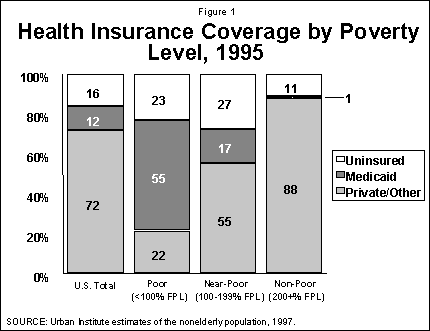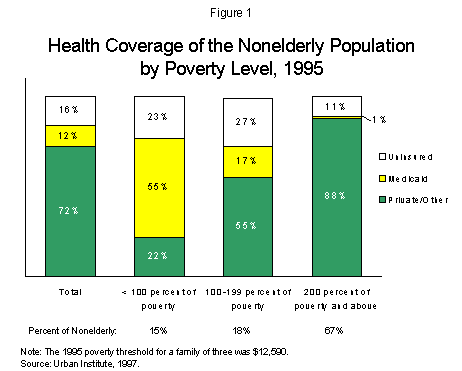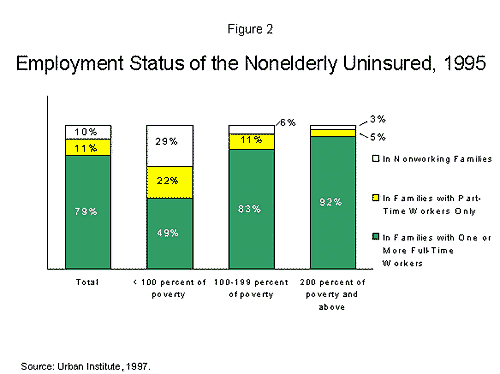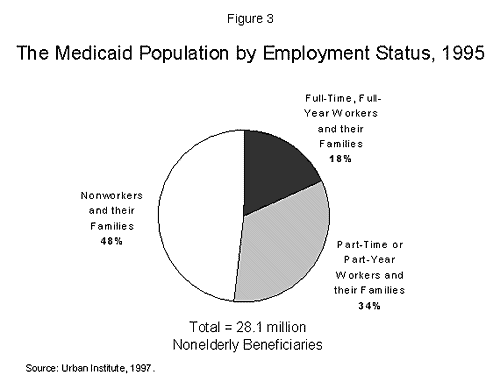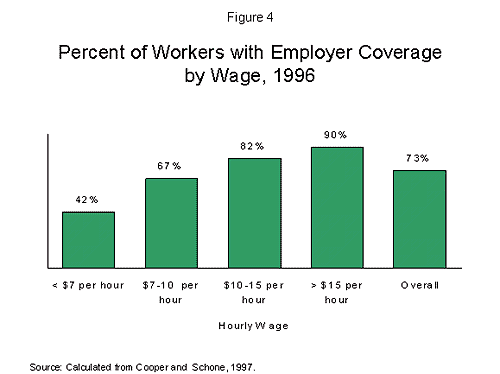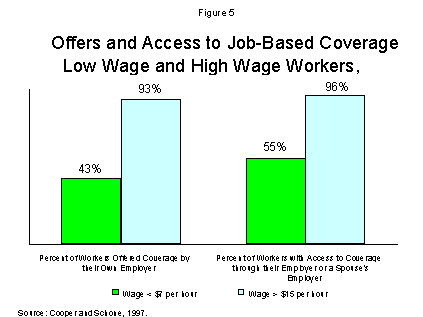Part 2
In addition to the state exit studies,24 another source of evidence about the impacts of loss of cash assistance can be found in the set of evaluations of the impacts of welfare-work initiatives. Several program evaluations contain data which may suggest that one unintended consequence of state efforts to increase employment among families receiving assistance could be a decline in health care coverage:
- The National JOBS Program Evaluation measured the impacts of employment efforts at a set of sites around the country using experimental design, where one set of families were subject to program participation requirements and another set were not. Three sites operated a “labor force attachment” model, focusing on rapid job placements. In those sites, two years after families entered the study, the employment rates were higher for the experimental group (42.5% versus 34.4% for a control group) but the percent covered by Medicaid or private health insurance during the month before the survey was lower for the experimental group (77.4% versus 82.7% for the control group.) Thus, the focus on rapid employment had led to an eight percentage point increase in the number of families with employment, but a five percentage point decline in the number covered by either Medicaid or private health insurance.25
- In Florida’s Project Independence, 45% of a sample of those subject to Project Independence requirements were employed at some point in a two-year period and their most recent job did not provide health benefits; for the control group, the comparable figure was 37%.26
- The Riverside County GAIN Program has often been recognized for its large impacts in raising employment rates among those subject to its requirements. The evaluation of the program found that in a survey interview two to three years after orientation, 27% of those subject to program requirements (as compared with 18% of members of a control group) reported that Medicaid or other health insurance did not personally cover them.27
Thus, in each of these instances, the program was successful in raising employment entries, but one unintended consequence was a decline in health care coverage for affected families.
3. Findings from State Benefit Termination/Sanction Studies Concerning Medicaid Consequences of Loss of AFDC/TANF
Another set of studies focus specifically on families losing assistance due to sanctions. As noted, until fairly recently, state sanction policies only terminated assistance to the parent rather than to the entire family when a single parent failed to comply with program requirements, but in the last years of AFDC, states began to make use of full-family terminations, and under TANF, such policies have become widespread. The use of full-family terminations has raised many questions about the impacts of such policies on the well-being of parents and children, though to date, there are only a handful of studies that expressly look at the impacts of such terminations.
When a sanction occurs, it is possible that the parent’s Medicaid coverage is being terminated as a matter of sanction policy, but under the law applicable both before and after TANF, the imposition of the penalty on the parent should not have affected the childrens’ Medicaid coverage.
One of the first indications that loss of cash assistance might be associated with loss of Medicaid came in a review issued by the General Accounting Office of early state experiences with benefit terminations. At the time of the report (May 1997) most states did not have significant numbers of benefit terminations for noncompliance with program rules. Three states with early experiences were Massachusetts, Iowa, and Wisconsin. In each of these three states, the level of Medicaid coverage fell substantially after benefit termination. Surveys conducted in the range of two to five months after termination of benefits showed:
- in Massachusetts, the share of families in which at least one family member received Medicaid fell from 100% to 58.5%;
- in Wisconsin, the share of families in which at least one family member received Medicaid fell from 100% to 53.5%;
- in Iowa, the share of families in which at least one family member received Medicaid fell from 86.3% to 54.4%.
Declines were also seen in food stamp receipt. The GAO noted that “officials in all three states expressed surprise at the amount of the decline in receipt of food stamps and Medicaid among households losing AFDC benefits.”28
Iowa engaged in a more detailed study of families whose assistance was denied or terminated for failure to comply with requirements to enter into or follow through with a Family Investment Agreement (FIA).29 Data in that study suggests that in about one-third of sanctioned families, neither the parent nor children were receiving Medicaid, and that in about 28% of sanctioned families, neither the parent nor children were receiving either Medicaid or employer-based coverage. As Iowa’s program was originally designed, a family that did not comply with requirements would enter into a “Limited Benefit Plan,” in which the family would receive the same level of assistance for a three month period, receive reduced assistance for another three months, and then enter into a six month period of ineligibility; during this time, the family should have remained Medicaid-eligible if financially eligible, although families entering employment while subject to a Limited Benefit Plan (LBP) would not qualify for transitional Medicaid. The evaluation included a survey of families in Months 10 or 11. By that point, most (52.6%) families whose assistance was terminated under the LBP rules had been employed at least once since losing cash assistance. For those who had been employed, their most recent job had offered health insurance in 36% of the cases, though only 11% of the employed had actually received employer-based insurance.30 In total, then, about 5.6% of respondents (10.6% of the 52.6% who had entered employment) were receiving employer-based health coverage, and a total of 66.4% of respondents were receiving Medicaid. Thus, it appears that about 28% of those under sanction were not receiving either Medicaid or employer-based health care coverage.
An even larger drop in Medicaid receipt after sanctioning was found in Michigan. Michigan conducted a study examining the first 168 cases that received full-family sanctions when Michigan began to implement such sanctions in April 1996. Of the cases, almost a quarter (24%) were either reopened or in pending status. However, of those still closed, 41% were not active for Medicaid.31 Michigan officials note, however, that the sanction population may be significantly different from the overall population receiving cash assistance, and that the growth in the average number of individuals receiving Medicaid through Michigan’s transitional Medicaid program and Healthy Kids program in 1998 substantially exceeds the reduction in the number of individuals receiving TANF assistance.
C. Why would exiters lose Medicaid?
The exit/sanction studies make clear that a substantial share of children and parents leaving AFDC/TANF lose Medicaid, either immediately or in a short period of time. The studies do not, however, offer any explanation of why this Medicaid drop occurs. There are several possible explanations and different explanations may apply to different states or even to different offices. In addition, whatever the reasons for the drops in enrollment under prior law, a state wishing to prevent this result can, to a significant extent, prevent comparable drops under TANF through the state’s choices in implementing Section 1931 eligibility.
Some of the possible reasons for the drop in Medicaid enrollment after leaving AFDC/TANF are:
- Family members may no longer be eligible. This is less likely to be the explanation for younger children, though it may explain some of the drop for parents and older children. As noted, the principal pathway to continued eligibility for parents and older children has been transitional Medicaid. However, under AFDC, transitional Medicaid would only have been available to those leaving AFDC due to employment or child or spousal support, and families often exit for other reasons. If the family did not exit due to employment, the family’s subsequent employment would not be sufficient to result in eligibility for transitional Medicaid. Even if the family exited AFDC due to employment, the family might not have qualified for transitional Medicaid if, for example, the family had not received AFDC for at least three of the last six months before exiting due to employment. And, once the family begins receiving transitional Medicaid, the family may lose eligibility for various reasons.32
- Family members may not seek transitional Medicaid because they do not know about it. In South Carolina’s most recent exit study, 84% of respondents knew that children could continue to get Medicaid after leaving welfare but only 55% knew that adults who left welfare for work might continue to get Medicaid. Under the law, a state has an obligation to determine continuing eligibility even if the family does not request it, but a parent who does not know about transitional Medicaid may not understand the importance of reporting that she is leaving assistance due to employment.
- States may not code families as leaving assistance due to employment although that is the reason for the exit. For example, in Maryland’s exit study (which does not provide information on health care coverage), 11.2% of a sample of closed cases had been coded as closed because “payee started work or has higher earnings” while state employment and wage data indicated that at least half of payees were working in the quarter in which they left assistance.33
- State procedures may erroneously terminate Medicaid or not provide for an effective mechanism to determine continuing eligibility. For example, North Carolina officials recently announced their intention to investigate whether local social services workers erroneously cut off Medicaid for 24,000 children who were no longer receiving Medicaid two months after their family stopped receiving TANF.34
- Parents may be discouraged or confused after loss of TANF assistance. Several researchers who were involved in conducting exit studies raised the possibility that after TANF assistance was terminated, families might fail to provide needed information for Medicaid redeterminations or choose not to do so because they wanted no further contact with the state or might even be confused as to whether Medicaid for family members had been terminated. A recent review of the impact of federal welfare changes on Medicaid noted that several states had acknowledged that problems in the redetermination process could be impacting Medicaid continuations.35
Whatever the reasons under prior law, it is important to appreciate that at least some of the drop-off in Medicaid enrollment can be prevented through attention to state administrative procedures and by state choices in implementing the Section 1931 eligibility criteria.
In attending to administrative procedures, a state can focus on outreach efforts and on attention to those stages at which drop-off or non-enrollment is most likely to occur. For example:
- Massachusetts indicates that in the last two years, the state has expanded automatic enrollment of closed AFDC/TANF cases into the MassHealth (Medicaid) Program to extend to all closed AFDC/TANF case closings. In addition, the state indicates that it has undertaken an extensive marketing campaign to inform low income families about the availability of health insurance through the MassHealth Program, and has begun an automated outreach process to recipients denied eligibility for TANF at the point of application for assistance.
- South Carolina indicates that after becoming aware of initial evidence of problems in ensuring uninterrupted Medicaid coverage, the state took measures to improve receipt of Medicaid for eligible families. The agency began showing a videotape to recipients to explain how and when support services continue after closure of the welfare case. Case managers were instructed to question clients who request voluntary closure of assistance cases to determine if the client had become employed; if earnings were verified, the case would be closed for earnings rather than voluntary closure so that the family could qualify for transitional benefits. The state’s efforts may have resulted in increased awareness of the availability of continued Medicaid benefits; in quarterly surveys, the share of respondents indicating awareness that children could continue to get Medicaid after leaving welfare increased from 79% to 84% between the first and third surveys; the share indicating awareness that adults leaving welfare for work may continue to get Medicaid increased from 40% to 55%.36
- Indiana indicates that it has initiated an extensive outreach effort for Medicaid-eligible children that includes efforts to enroll children through sites such as health clinics, day care centers, schools, hospitals, and that the state has begun planning a strong media campaign for its outreach.37
As noted earlier, under Section 1931, a family’s Medicaid eligibility no longer is based on whether the family receives TANF and a state is free to broaden the effective income and resource rules that determine eligibility under Section 1931.38 Thus, if a state wishes to ensure that family members continue to be eligible for Medicaid after entering low-wage employment, the state may do so under Section 1931. A continuation of Section 1931 eligibility for those entering low-wage jobs would address some of the problems presented by the eligibility restrictions and administrative requirements of transitional Medicaid.39 Moreover, it could help to address the problems presented by the limited receipt of employer-based health care for families exiting TANF due to employment.
The TANF exit studies underscore the importance of using Section 1931 to broaden Medicaid eligibility for working poor families. Without such a broadening of eligibility, it seems likely that one consequence of TANF implementation will be fewer families receiving TANF, more families engaged in employment, and yet reduced health care coverage for poor parents and children.
This paper was prepared for the Kaiser Commission on Medicaid and the Uninsured by Mark Greenberg, Center for Law and Social Policy. The author would like to thank the Kaiser Family Foundation for their support of this project and Cindy Mann, Jocelyn Guyer, and all state officials who reviewed and commented on this paper.
1 A set of eligibility rules limited when and how long families could qualify for transitional Medicaid. Among the most significant, the family must have received AFDC for three of the last six months before exiting due to hours of employment, earnings, or loss of AFDC earnings disregards; and, in order to receive transitional Medicaid for the entire twelve months, the family would need to meet quarterly reporting requirements, maintain employment and have earnings not exceeding 185% of poverty. For a detailed discussion of transitional Medicaid rules under AFDC, see Greenberg, The JOBS Program: Answers and Questions (2nd ed., Center for Law and Social Policy, 1992), pp. 245-263.
2 More precisely, the income and resource requirement is that the individual must meet the income and resource standards for determining AFDC eligibility under the State AFDC Plan in effect on July 16, 1996, using the income and resource methodologies under that plan. The family composition rules are the AFDC definition of “dependent child” and the AFDC listing of the relatives living with a dependent child who could qualify for assistance. As a practical matter, single parent families and two-parent families that met prior AFDC-UP or AFDC-Incapacity rules will meet the family composition rules States wishing to broaden the circumstances under which two-parent families meet the family composition rules may do so by modifying the definition of when a two-parent family is considered to be “unemployed.” See 63 Fed. Reg. 42270-75 (August 7, 1998).
3 The law allows a state to: lower its income standards, but not below the standards applicable under its AFDC state plan on May 1, 1988; increase its income or resource standards by an amount not exceeding the Consumer Price Index; use “less restrictive” income and resource methodologies than those used under the plan as of July 16, 1996; and if the state had had an AFDC waiver that had the effect of expanding Medicaid eligibility, the state may elect to continue that policy for Section 1931 purposes even after the time that the waiver would have expired.
4 See Peller and Shaner, Medicaid Eligibility Standards for Low-Income Families and Children: State Implementation of the Personal Responsibility and Work Opportunity Reconciliation Act of 1996 (American Public Welfare Association, May 1998).
5 For example, a study of the caseload decline in Alabama concluded that the most important variable in explaining the decline was a reduction in the percentage of applications that were approved for assistance, with the percentage of approvals falling from 63% to 46% over an eighteen month period. Dawson, Demystifying the Caseload Reduction (Alabama Arise, 1997).
6 The HHS Temporary Assistance for Needy Families (TANF) Program First Annual Report to Congress (August 1998) reports that in recent years, the likelihood that an AFDC/TANF adult would be employed in the next year has increased. Of adults receiving AFDC in 1991, 18.8% were employed in March 1992; the share of previous-year recipients who were employed the next March increased each subsequent year, reaching 24.6% in 1996 and then increased to 31.5% in 1997.
7 Gallagher, et al., One Year After Federal Welfare Reform: A Description of State Temporary Assistance for Needy Families (TANF) Decisions as of October 1997 (Urban Institute, May 1998), p. V-6.
8 South Carolina Department of Social Services, Division of Program Quality Assurance, Survey of Former Family Independence Clients: Cases Closed During April through June 1997 (June 1998), p 11.
9 The South Carolina figures reported for this most recent period reflect an improvement in health care coverage as compared to earlier periods in which the same questions were asked. South Carolina’s survey is the third in a series of surveys looking at the circumstances of a sample of families after leaving cash assistance. In the first study (focusing on exiters from October-December 1996), 66% of children were covered by Medicaid and 81% had some form of coverage; in the second study (focusing on exiters from January-March 1997), 71% of children were covered by Medicaid and 81% had some form of coverage. As to adults, in the first study, 28% were covered by Medicaid and 47% had some form of coverage; in the second study, 27% were covered by Medicaid and 37% had some form of coverage. See South Carolina Department of Social Services, Division of Program Quality Assurance, Survey of Former Family Independence Clients: Cases Closed During October through December, 1996 (November 1997) and Survey of Former Family Independence Clients: Cases Closed During January through March 1997 (March 1998).
10 Bureau of Business and Economic Research, University of New Mexico, Survey of the New Mexico Closed-Case AFDC Recipients, July 1996 to June 1997 (September 1997).
11 Fein, The Indiana Welfare Reform Evaluation: Who Is On and Who is Off? (Abt Associates, September 1997) at pp. 7-9.
12 At the time of the survey, 64% of respondents not receiving TANF were working, and of those working 62% reported that they were in jobs offering health insurance. However, the survey does not indicate what share of families were actually receiving employment-based health insurance. Fein, The Indiana Welfare Reform Evaluation: Who Is On and Who is Off? (Abt Associates, September 1997) at pp. 7-9.
13 Management Reports and Data Analysis, DSHS Economic Services Administration, Washington’s TANF Single Parent Families Shortly After Welfare: Survey of Families Which Exited TANF between December 1997 and March 1998 (July 1998), supplemented by unpublished responses to survey questions.
14 Some part of the difference between these two figures may be attributable to the possibility that respondents gave different responses to different questions; some part may be attributable to the difference between coverage in current employment and coverage in employment at some point in the prior twelve months.
15 Management Reports and Data Analysis, DSHS Economic Services Administration, Washington’s TANF Single Parent Families Shortly After Welfare: Survey of Families Which Exited TANF between December 1997 and March 1998 (July 1998), supplemented by unpublished responses to survey questions.
16 Among those reporting being worse off, 49% reported no adult heath coverage, and 30% reported no child coverage. Among those reporting being about the same, 36% reported no adult health coverage and 21% reported no child coverage. Among those reporting being better off, 30% reported no adult health coverage and 16% reported no child coverage. Overall, 60% reported being better off, 22% reported being about the same, and 18% reported being worse off. Of those saying they were worse off 52% said they were likely to return to welfare within the next six months.
17 DSHS Economic Services Administration, A Baseline Analysis of TANF One-Parent Families: Findings from 1997 Client Survey (February 1998), at p.6.
18 DSHS Economic Services Administration, A Baseline Analysis of TANF One-Parent Families: Findings from 1997 Client Survey (February 1998), at p.6.
19 ancoske, Kemp and Lindhorts, Exiting Welfare: The Experiences of Families in Metro New Orleans (Welfare Reform Research Project, School of Social Work, Southern University at New Orleans, June 1998).
20 Mancoske, Kemp and Lindhorts, Exiting Welfare: The Experiences of Families in Metro New Orleans (Welfare Reform Research Project, School of Social Work, Southern University at New Orleans, June 1998).
21 Pawasarat, Employment and Earnings of Milwaukee County Single Parent AFDC Families: Establishing Benchmarks for Measuring Employment Outcomes Under “W-2” (University of Wisconsin-Milwaukee, Employment and Training Institute).
22 Pawasarat, Employment and Earnings of Milwaukee County Single Parent AFDC Families: Establishing Benchmarks for Measuring Employment Outcomes Under “W-2” (University of Wisconsin-Milwaukee, Employment and Training Institute). The actual level of non-receipt may be somewhat higher because Medicaid status is not available for 20% of cases in which the family had ceased receiving AFDC and was still receiving Food Stamps. Also, note that the family was coded as receiving Medicaid if any family member received Medicaid.
23 Summary of Surveys of Welfare Recipients Employed or Sanctioned for Noncompliance (March 1998) prepared for Tennessee Department of Human Services by Bureau of Business and Economic Research/Center for Manpower Studies, University of Tennessee, Memphis, Tennessee (March 1998).
24 One additional state study of exiters, from Kentucky, found that almost half of children were reported to have no health care coverage, though the low survey response rate and possible ambiguities in the wording of questions make it difficult to be confident of the survey results. Cummings and Nelson, From Welfare to Work: Welfare Reform in Kentucky (Center for Policy Research and Evaluation, Urban Studies Institute, University of Louisville, January 1998). A telephone survey was conducted in December 1997 of former TANF recipients who had been discontinued between January and November 1997. The response rate was low: only 17% (560 respondents out of 3225 attempts). About half (49%) of respondents reported that they had left assistance because they got a job. The survey asked “Are your children covered by health insurance?” According to respondents, almost half (48%) of children were not covered by health insurance; 49.5% of children were covered. However, there may be some ambiguity as to whether respondents whose children were covered by Medicaid would answer yes to the question. Another question included Medicaid on the list in a question, “Do you currently receive any of the following benefits…?” Only 28.4% of respondents responded yes, but the question could have been interpreted as being directed only at the adult respondent.
25 Executive Summary, The JOBS Evaluation: Early Findings on Program Impacts in Three Sites (U. S. Dept. Of Health and Human Services, 1995), Table ES-1. In sites emphasizing a “human capital development” approach, at the two-year point, the employment impacts were smaller and not statistically significant (35.1% of experimentals and 32.4% of controls were employed); there was also a small, and not statistically significant, difference in the percent covered by Medicaid or private health insurance in the prior month (79.2% of experimentals, 81.8% of controls. A subsequent report provides additional information on employment and other impacts in the JOBS evaluation sites, but the subsequent report does not provide further information on Medicaid/health coverage impacts. See Hamilton, et al., National Evaluation of Welfare-to-Work Strategies, Two-Year Findings on the Labor Force Attachment and Human Capital Development Programs in Three Sites (U.S. Department of Health and Human Services and U.S. Department of Education, December 1997).
26 Kemple, Friedlander, and Fellerath, Florida’s Project Independence: Benefits, Costs, and Two-Year Impacts of Florida’s JOBS Program (Manpower Demonstration Research Corp., 1995), p. 106.
27 Riccio, Friedlander, and Freedman, GAIN: Benefits, Costs, and Three-Year Impacts of a Welfare-to-Work Program (Manpower Demonstration Research Corporation, 1994), p.178.
28 GAO/HEHS-97-74, Welfare Reform: States’ Early Experiences with Benefit Termination (May 1997), pp. 42-43.
29 Fraker, Nixon, Losby, Prindle, and Else, Iowa’s Limited Benefit Plan (Mathematica Policy Research, May 1997), at p. 74. FIA describes the agreement between the individual and state specified goals, activities, and time frames for enacting these goals and the ultimate goal of self-sufficiency.
30 Of the 36.4% who had had health insurance available in their most recent job, 10.^% received the insurance, 10.6% did not receive the insurance due to its costs; and 15.2% did not receive it for another reason. Fraker, Nixon, Losby, Prindle, and Else, Iowa’s Limited Benefit Plan (Mathematica Policy Research, May 1997), at p. 74.
31 Colville, Moore, Smith and Smucker, A Study of AFDC Case Closures Due to JOBS Sanctions, April 1996 AFDC Case Closures (Michigan Family Independence Agency, May 1997).
32 For example, Kentucky officials note that they recently conducted a review of all cases discontinued effective March 1998 for a reason that would result in transitional Medicaid eligibility; 706 cases were identified, and transitional Medicaid had been established in each case. The next month, 51 of those cases were identified as losing transitional Medicaid eligibility, and a review of a random sample of half of those cases found the terminations to be valid, with the most frequent reasons being recipient request for termination, recipient having moved out-of-state, and reinstatement of TANF eligibility.
33 Born, Life After Welfare: Second Interim Report (School of Social Work, University of Maryland, March 1998)., pp. 18-19.
34 See Children’s Loss of Medicaid Probed, Raleigh News & Observer, June 12, 1998.
35 Ellwood and Ku, Welfare and Immigration Reforms: Unintended Side Effects for Medicaid (Health Affairs, May/June 1998, pp. 137, 141).
36 See South Carolina Department of Social Services, Division of Program Quality Assurance, Survey of Former Family Independence Clients: Cases Closed During April through June 1997 (June 1998), p. 20.
37 Most other states responding to a preliminary draft of this report also emphasized ongoing or newly initiated outreach efforts.
38 Technically, the mechanism that a state could use would be to adopt a “less restrictive methodology” for calculating income eligibility for Section 1931-based Medicaid. A state wishing to ensure that low-wage working families retained Medicaid eligibility might provide, for example, that the first $500 (or some other figure) from earnings would not be counted in determining whether the family met the income standards applicable to Section 1931 eligibility. The practical effect of this less restrictive methodology would be a broadening of the circumstances where low-wage working families qualified for Section 1931 Medicaid. For a more detailed discussion of state options in expanding coverage through use of Section 1931, see Guyer and Mann, Taking the Next Step: States Can Now Expand Health Coverage to Low-Income Working Parents Through Medicaid (Center on Budget and Policy Priorities, July 1998), http://www.cbpp.org/702mcaid.html.
39 For example, Washington State has implemented a more generous earned income disregard (50% of gross earnings), more liberal treatment of assets, and broader eligibility for two-parent families under TANF, and has extended those same standards to Section 1931 eligibility. Return to top
Policy Brief Part 1 Part 2Library Index
